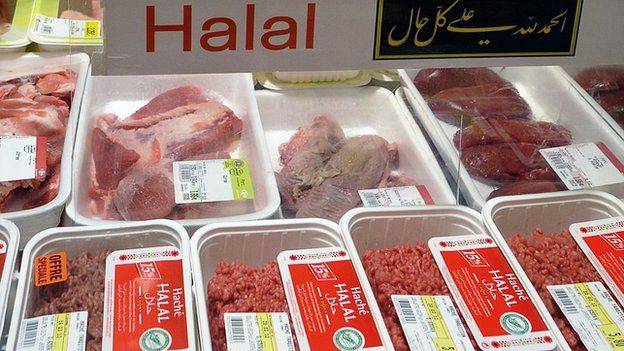
What is the difference between Halal and Haram
Halal and Haram in the Qur'an
What is Halal Meat

Picture Credit: BBC
You might have wondered what is a 'Halal' chicken, after all, all chickens look the same! So, what is it that makes this chicken, or beef, or mutton 'Halal' and others not? What exactly is the difference between Halal and non-Halal meat?
- The slaughter of the animal must be carried out by a Muslim.
- The animal must not be dead.
- Animals for slaughter must not be grouped together or allowed to watch the slaughter of other animals in their herd.
- As with most things Muslims do, it must begin with the utterance of 'Bismillah', which means 'In the name of Allah.
- The animal must be slaughtered with a precise cut to its throat, severing it's carotid artery, trachea and jugular veins.
- The slaughter must be carried out with the use of a razor-sharp knife to ensure a quick death and that the animal dies as quickly as possible.
- The animal must be hung upside down in order to allow all the blood to drain.
Find Halal Food and Restaurants Near You
Types of Halal Food
- Meat that is slaughtered in the Islamic manner
- Fish and other creatures of the sea (they need not be slaughtered)
- Fruits and vegetables
- Dairy products (barring cheese made using non-Halal rennet, etc.)
Types of Haram Foods

- Meat that is not slaughtered according to the methods prescribed by Qur’an and Hadeeth.
- Alcohol
- Pork or pork by-products
- Blood
- Food that may contain any combination of the above three (gelatin made from Haram meat, cakes with alcohol, etc.).
Delving
further into the category of meat that is not Halal also considers the
types of animals that one is not allowed to eat and the way in which the
animal dies. These are the types of animals/meat that are Haram:
- Carnivorous animals/birds (animals that eat the flesh of other animals or drink their blood).
- Animals that have been dedicated to or slaughtered in the name of anyone other than Allah.
- Animals/birds that have been dedicated to idols.
- Animals/birds that have died due to natural causes.
- Animals/birds that die due to strangulation.
- Animals/birds that die from being beaten.
- Animals/birds that die falling down from a height.
- Animals/birds that are killed and gored by a beast of prey.
- Animals that live on both land and in water (amphibians) such as frogs and salamanders.
Why Do Muslims Eat Halal Food

Picture Credit: The Muslim Press
How To Identify Halal Foods

- Packaged Halal foods often carry a “Halal Certified” logo awarded by the Muslim council or Halal supervisory board of your country.
- Some foods simply have the word “Halal” printed on them; this is fine too, but be careful in considering whether you are able to trust the source.
- If there is no Halal symbol, look for the vegetarian sign. This is the one that looks like a green square with a green dot in the middle. Check the ingredients to make sure it doesn't contain alcohol (most packaged goods will not), and you're good to go.
- Always check the labels. Checking the ingredients listed on the package is your best bet on figuring out if the food is Halal or not.
- In the case of confectioneries, look out for “gelatin” listed in the ingredients. If the package has no Halal or vegetarian symbol, then it's most probably not Halal gelatin.
- Some foods containing the non-vegetarian symbol, which looks similar to the vegetarian symbol but maroon in colour, can also be Halal. This may be because it contains eggs, and since there are no Halal and Haram eggs, there is no need to worry. If this is the case, it is usually mentioned underneath the maroon square and circle symbol.
- Check for foods containing emulsifiers. Look for Halal and Haram E-Codes online, or you can even download apps that scan the ingredients and tell you if it's Halal or not. But many emulsifiers may be derived from plant or animal sources (maybe Halal or non-Halal), so not all products will be the Halal or Haram.
- Nevertheless, here are a few of the Haram E-Codes to look out for:
- - E120 Cochineal: red colouring derived from female insects.
- - E441 Gelatine: derived from the bones/hides of cattle/sheep.
- - E542 Edible Bone Phosphate: extracted from animal bones.
- - E904 Shellac: a resin from the lac insect.
- If you are eating at a restaurant that claims to be Halal certified, insist on seeing their certification.
- If they do not have one, they will tell you that they source the meat from Halal suppliers and do not serve pork or alcohol. In this case, ask to see the certification of their meat supplier.
- Refrain from eating, even vegetarian dishes, from restaurants that serve dishes that contain alcohol, non-Halal meat or pork. This is because they probably use the same utensils to cook both dishes, and it is quite possible that there is cross-contamination even if the dishes have been washed.
- Some restaurants serve alcohol on the side. If everything else checks out, this is fine, but if there are other options, it would be better to go for them.
- If you're looking to buy Halal meat, local Muslim-owned butcheries are the ideal place for them.
- Muslim-owned restaurants also are credible, but if it is a chain restaurant, check their certifications before eating there.





